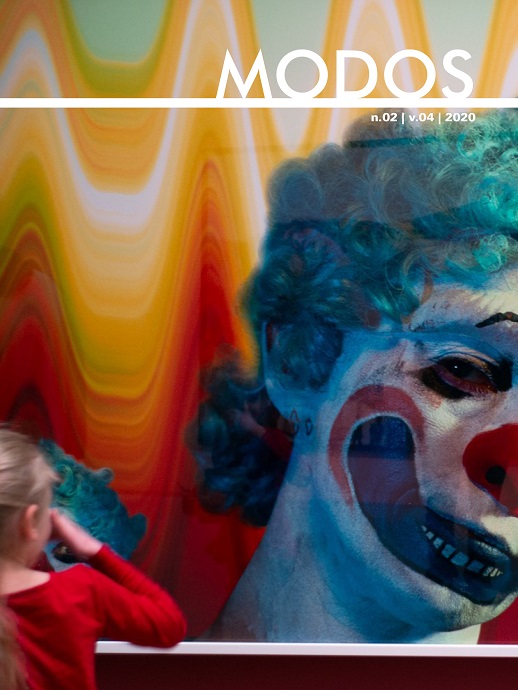Abstract
This article discusses the sketch Daedalus and the Minotaur, conceived by Peter Paul Rubens, in 1636, for the series commissioned by the Spanish king Philip IV. In this work, Rubens represents a more human Minotaur, in a peculiar situation, establishing a dialogue with a long tradition, which goes from classical antiquity to the 17th century, from which he both approaches and moves away. For our analysis, we take, as guidelines, literature and ancient iconography about the myth of the Cretan monster, as well as later representations, which differ from the canonical form. We also take into consideration some studies about the series commissioned by the king and the aforementioned draft, especially in Díez-Platas (2005) and Alpers (1971).
References
ALCIATI, A. A book of emblems. Translated by John Moffitt. Jefferson: McFarland, 2004.
ALPERS, S. Corpus Rubenianum Ludwig Burchard: part IX. London: Phaidon, 1971.
APOLLODORUS. The Library. Disponível em:<http://www.theoi.com/Text/Apollodorus1.html>. Acesso em: 15 abr. 2020.
BRANDÃO, J. Dicionário mítico-etimológico. Petrópolis: Vozes, 2000, v. 1.
______. Dicionário mítico-etimológico. Petrópolis: Vozes, 2000b. v. 2.
CASADIEGOS, Y. P. El Minotauro en su laberinto. Aposta, Revista de Cirncias Sociales, Madrid, n. 3, p.1-34, 2003.
DÍEZ-PLATAS, F. El Minotauro: ¿una imagen ‘al pie de la letra?’, Quintana, Santiago de Compostela, n. 4, p. 141-152, 2005..
______. A companion for Dedalus: the exceptional iconography of Rubens’ Minotaur. [S.d.] Disponível em: <https://www.academia.edu/926437/A_companion_for_Daedalus_the_exceptional_iconography_of_Rubens_Minotaur>. Acesso em: 10 abr. 2020.
FERREIRA, J. R. Labirinto e Minotauro: mito de ontem e de hoje. Coimbra: Fluir Perene, 2008.
GEORGIEVSKA-SHINE, A.; SILVER, L. Rubens, Velázquez and the King of Spain. Farnham: Ashgate, 2014.
HESÍODO. Teogonia. Tradução Sueli Maria de Regino. São Paulo: Martin Claret, 2010.
HYGINUS. Fabulae. Disponível em:<http://www.theoi.com/Text/HyginusFabulae1.html#33>. Acesso em: 14 abr. 2020.
OVÍDIO. Metamorfoses. Tradução Paulo Farmhouse Alberto. Lisboa: Cotovia, 2007.
______. Cartas de amor: as heróides. Tradução Dunia Marinho Silva. São Paulo: Landy, 2003.
______. Ars amatoria. Disponível em: <http://www.sacred-texts.com/cla/ovid/lboo/lboo58.htm>. Acesso em: 15 abr. 2020.
PAUSANIAS. Description of Greece. Disponível em: <http://www.theoi.com/Text/Pausanias1A.html>. Acesso em: 13 abr. 2020.
PLUTARCO. Vidas paralelas. Tradução Gilson César Cardoso. São Paulo: Paumape, 1991a. v. 1.
______. Vidas paralelas. Tradução Gilson César Cardoso. São Paulo: Paumape, 1991b. v. 3.
SÊNECA, Fedra. Tradução José Eduardo do Prado Nery. Rio de Janeiro: Agir, 1985.
SIGANOS, A. Le Minotaure et son mythe. Paris: Presses Universitaires de France, 1993.
SICULUS, DIODORUS. Library of History. Disponível em: <http://www.theoi.com/Text/DiodorusSiculus4A.html>. Acesso em: 14 abr. 2020.
TAVARES, D. A. De Minotauro a Asterion: transmutações do prisioneiro do labirinto entre os séculos XIV e XX. Tese (Doutorado em Literatura e Cultura). Instituto de Letras, Universidade Federal da Bahia, Salvador, 2018.
VIRGÍLIO. Eneida. Tradução Carlos Alberto Nunes. São Paulo: 34, 2014.

This work is licensed under a Creative Commons Attribution-NonCommercial-ShareAlike 4.0 International License.
Copyright (c) 2020 MODOS

